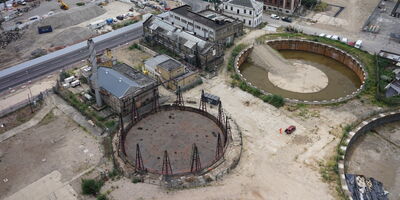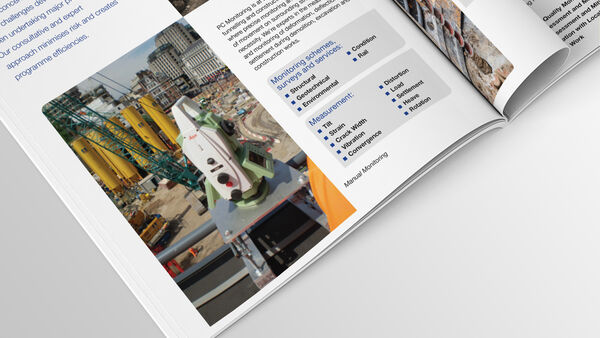
King's Road Park - Gasworks Redevelopment
View project
Plowman Craven's structural, geotechnical & environmental monitoring services - plus a range of construction surveying and rail track monitoring services - are integrated with our broader surveying and measurement offerings throughout the project lifecycle, helping to save our clients valuable time and create efficiencies in our delivery.
With a strong management team, industry leading expertise and the resources of the Plowman Craven group, we are a market leader in the structural, geotechnical and environmental sector.
Our construction monitoring services are also fully integrated with Plowman Craven’s Environmental Planning division - for centralised installation, management and delivery of a complete package.

It is not always straightforward to identify whether monitoring is required when undertaking construction works. However, here are a few questions to consider which may make the decision process more straightforward.
This list is not exhaustive and a positive answer to a question does not always indicate that monitoring is definitely required. It is certainly a good place to start, however, in order to understand whether further discussion with a specialist monitoring contractor is necessary.
This is a question commonly asked and the natural response is always to suggest it should commence as early in the project programme as possible. Ideally, it is always preferable to understand how structures or ground conditions naturally change through seasonal variations, and then use this information to define a baseline for future comparison.
However, obtaining a baseline over the course of a year or more is rare and often unfeasible due to both programme and cost constraints.
The key is to ensure that monitoring is established well in advance of any works that might have an influence, to ensure that stable data is obtained. It is also important to liaise with any key project stakeholders, such as London Underground or Network Rail, to understand their requirements for baseline monitoring.
Collecting good quality baseline data is vital if observations and trends are to be understood during the works.
Typically there is no ‘one-size-fits-all’ approach and each monitoring scheme should be considered on a case by case basis. However, here are a few questions you can ask yourself to establish which approach may be best suited:
Plowman Craven regularly works with clients who are considering either manual and/or automatic monitoring techniques and we are always happy to talk through the benefits of each approach. We also frequently provide unbiased cost comparisons so that the appropriate informed decisions can be made.
Over the last few years, a number of excellent resources have been created which help to both define and specify monitoring schemes. Whilst they should always be backed up by expert advice, these are a great place to start when trying to understand best practice and how monitoring can benefit a project.
A couple of our favourite examples can be found via the following links:
Ultimately, the main reason monitoring is required is to determine whether certain parameters are deviating away from their normal state. This might be the rotational movement of a retaining wall, an increase in pore water pressure or an increase in noise and vibration levels in comparison to ambient conditions. This in turn provides assurance to stakeholders, informs engineering decision making and ensures compliance with relevant obligations.
Therefore, the key to determining what monitoring is required and what equipment is to be used is to first identify the question you are trying to answer. It is not uncommon to see specific monitoring approaches or equipment included in specifications that will not provide results to validate the parameter in question. This can lead to misunderstandings when interpreting the results and, in extreme cases, compromised decision making. Always start with the problem and work backwards.
Another thing to consider is that the type of data that can be provided through monitoring regimes continuously changes.
Over the past few years a number of extremely innovative businesses have begun offering new monitoring products to the industry and they continue to develop them at a fast-moving pace. New advances allow parameters to be measured in ways that were not possible previously, providing more meaningful data in a greater range of situations.
Added to this are the benefits that improved data interpretation and analysis capabilities bring. It is becoming more and more common for monitoring data to be augmented and post-processed in a way which provides additional insights to clients, therefore speeding up the decision-making process. Design assumptions can now be validated at an almost real-time pace, increasing safety and opening up the potential for constant optioneering throughout the construction process.
At Plowman Craven, we are passionate about the possibilities new technical approaches can bring and we are always happy to share our thoughts with others!
Our structure ensures greater control, expertise, flexibility and efficiencies during a project.
We provide clients with technical solutions that help identify, manage & mitigate project risks.
Backed by a strong management team, our experience provides advice & support for clients.
Combined management, installation & efficient data presentation helps us to save clients money.
Advanced software packages & web-based platforms provide clients with full data access.
Our services can be synced with Plowman Craven’s BIM, Property & Infrastructure divisions.
Ensuring all buildings and surrounding structures remain stable during construction is a critical challenge for developers undertaking major projects, with precise monitoring and early warning of movement a necessity.
Our consultative and expert approach minimises risk and creates programme efficiencies.
Having worked on many major tunnelling and construction developments, we’re experts in the measurement and monitoring of deformation, deflection and settlement during demolition, excavation and construction works.
We monitor for Heave/Settlement, Distortion and Deformation in real time using web-based display and alert software. We are passionate about data visualisation and continuously strive to provide meaningful insights to our customers.
Comprehensive monitoring schemes will consider not only the protection of assets but will also provide data to support geotechnical design. Our team is highly experienced in monitoring ground movement during construction as well as the various techniques used to monitor changes in ground water conditions.
We have access to a number of Ground Investigation suppliers and regularly work with them to install instruments such as extensometers, inclinometers and piezometers. These instruments can be manually read or linked to bespoke data acquisition systems in order to provide near real-time measurements via our web-based data visualisation software.
Our instrumentation systems can also be used for detecting movement during excavation by incorporating sensors into piling and propping schemes.

Take a look at our Monitoring Brochure to find out more about our range of complementary services - Structural Monitoring, Environmental Monitoring & Engineering Services - and learn how our consultative approach can help create programme efficiencies.
In addition to manual and automated structural services, our consultation and participation during the design phases of a development means we’re well placed to provide expert advice on noise, dust, air quality and vibration monitoring through our in-house Environmental Monitoring and Planning division.
Combining our core services with those of our Environmental Monitoring team enables us to offer a unique service bundle to the Construction and Engineering industries that can help minimise environmental risks for clients, including reputational damage, potential legal action and costly delays due to local authority restrictions.
The importance of establishing and maintaining an accurate and robust survey control is a project fundamental and translates to topographic survey/BIM modelling in the early stages, setting out, monitoring and as built surveys during the construction phase.
Positional control during construction works is key to a successful and error-free project, particularly when verifying accuracies in the construction of pre-fabricated, modular tower blocks.
Plowman Craven can offer all of these services with an onsite survey presence throughout the project life cycle, ensuring the all-dimensional surveys are referenced to the same assured control grid and eliminating discrepancies.
Condition Surveys delivered by Plowman Craven present an accurate recording of the existing condition of a building or surrounding area.
The recording of the condition of buildings or structures assists in identifying costs for repairs, maintenance and improvement works prior to the acquisition, disposal or occupation of a property. It also helps to determine a scope required to enable fit-out works, and assists in protecting an individual or company’s interests prior to and after development.
We provide condition surveys and schedules of condition for a variety of property types including (but not limited to) office, retail, light industrial, and railway premises and structures.
When a development involves piling or other sub-surface works, it is essential that the geospatial relationship of items both above and below ground is determined to a high degree of accuracy and reliability.
This complete geospatial correlation helps to mitigate risk and assist in the avoidance of major disaster, considerable cost implications, reputable damage and construction delays.
Plowman Craven works closely with developers and underground asset owners to deliver precise correlation surveys for projects where Network Rail and London Underground assets are present.
In addition, our specialist in-house utilities division uses the latest technology to trace, identify and map all underground utilities and service routes including gas, water, telecoms, electricity and drainage.
Let’s discuss your requirements and see how our expertise can help on your next project.
Plowman Craven has 60 years’ experience providing integrated measurement and consultancy services to the property and infrastructure markets.


